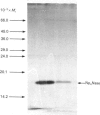Abstract
The P1P4-bis(5'-nucleosidyl) tetraphosphate asymmetrical-pyrophosphohydrolase from encysted embryos of the brine shrimp Artemia has been purified over 11,000-fold to homogeneity. Anion-exchange chromatography resolves two major species with very similar properties. The enzyme is a single polypeptide of Mr 17,600 and is maximally active at pH 8.4 and 2 mM-Mg2+. It is inhibited by Ca2+ (IC50 = 0.9 mM with 2 mM-Mg2+) but not by Zn2+ ions. It preferentially hydrolyses P1P4-bis(5'-nucleosidyl) tetraphosphates, e.g. P1P4-bis(5'-adenosyl) tetraphosphate (Ap4A) (kcat. = 12.7 s-1; Km = 33 microM) and P1P4-bis(5'-guanosyl) tetraphosphate (Gp4G) (kcat. = 6.2 s-1; Km = 5 microM). With adenosine 5'-P1-tetraphospho-P4-5"'-guanosine (Ap4G) as substrate, there is a 4.5-fold preference for AMP and GTP as products and biphasic reaction kinetics are observed giving Km values of 4.7 microM and 34 microM, and corresponding rate constants of 6.5 s-1 and 11.9 s-1. The net rate constant for Ap4G hydrolysis is 7.6 s-1. The enzyme will also hydrolyse nucleotides with more than four phosphate groups, e.g. Ap5G, Ap6A and Gp5G are hydrolysed at 25%, 18% and 10% of the rate of Ap4A respectively. An NTP is always one of the products. Ap2A and Gp2G are not hydrolysed, while Ap3A and Gp3G are very poor substrates. When the enzyme is partially purified from embryos and larvae at different stages of development by sedimentation through a sucrose density gradient, its activity increases 3-fold during the first 12 h of pre-emergence development. This is followed by a slow decline during subsequent larval development. The similarity of this enzyme to other asymmetrical-pyrophosphohydrolases suggests that it did not evolve specifically to degrade the large yolk platelet store of Gp4G which is found in Artemia embryos, but that it probably serves the same general function in bis(5'-nucleosidyl) oligophosphate metabolism as in other cells.
Full text
PDF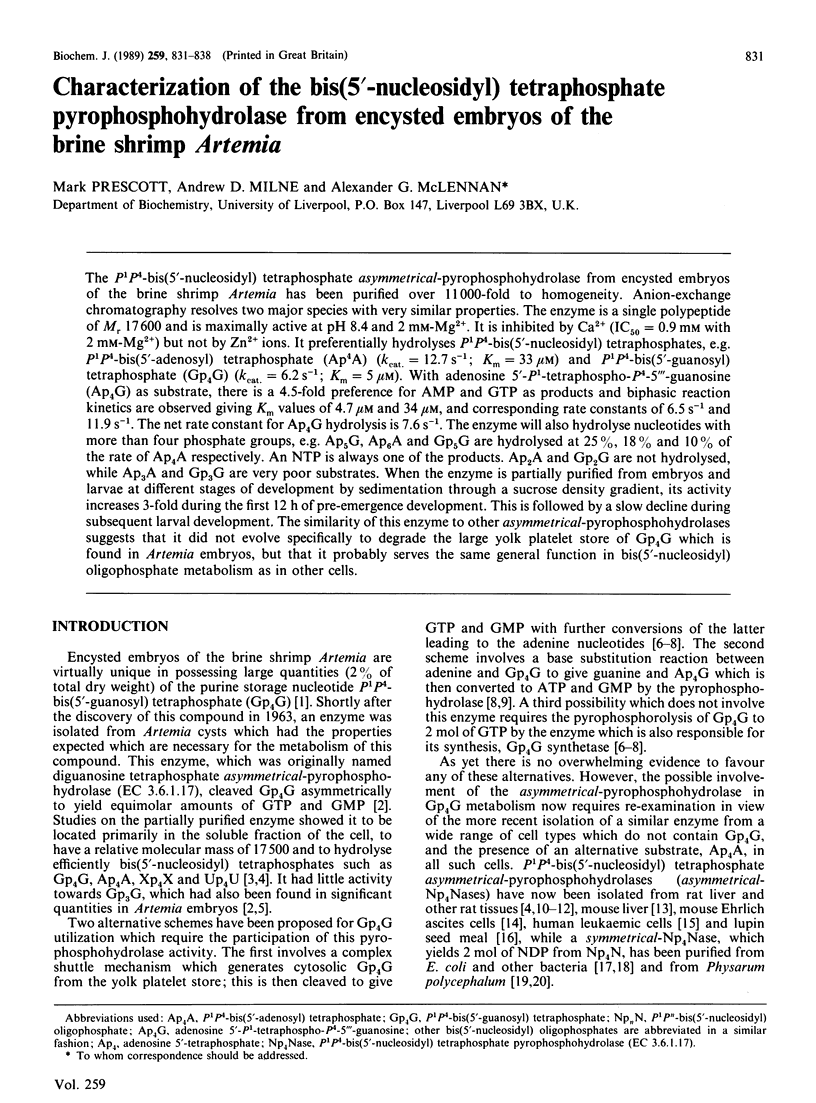
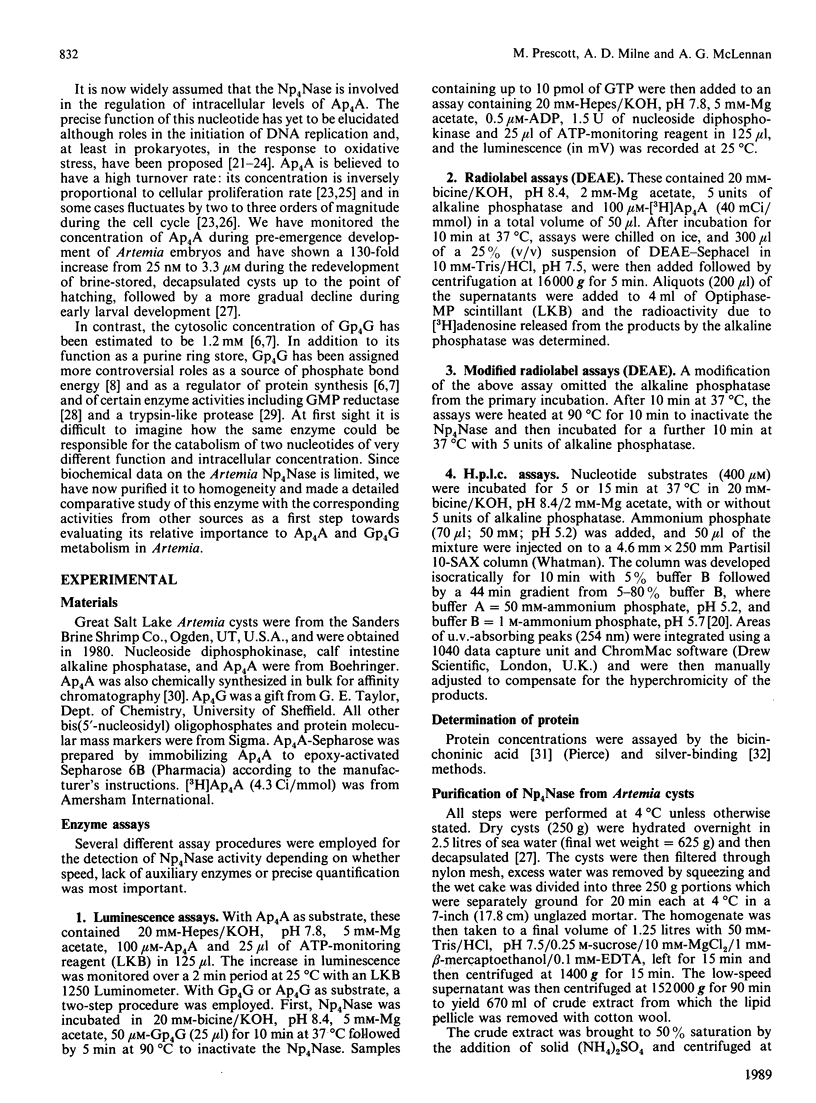
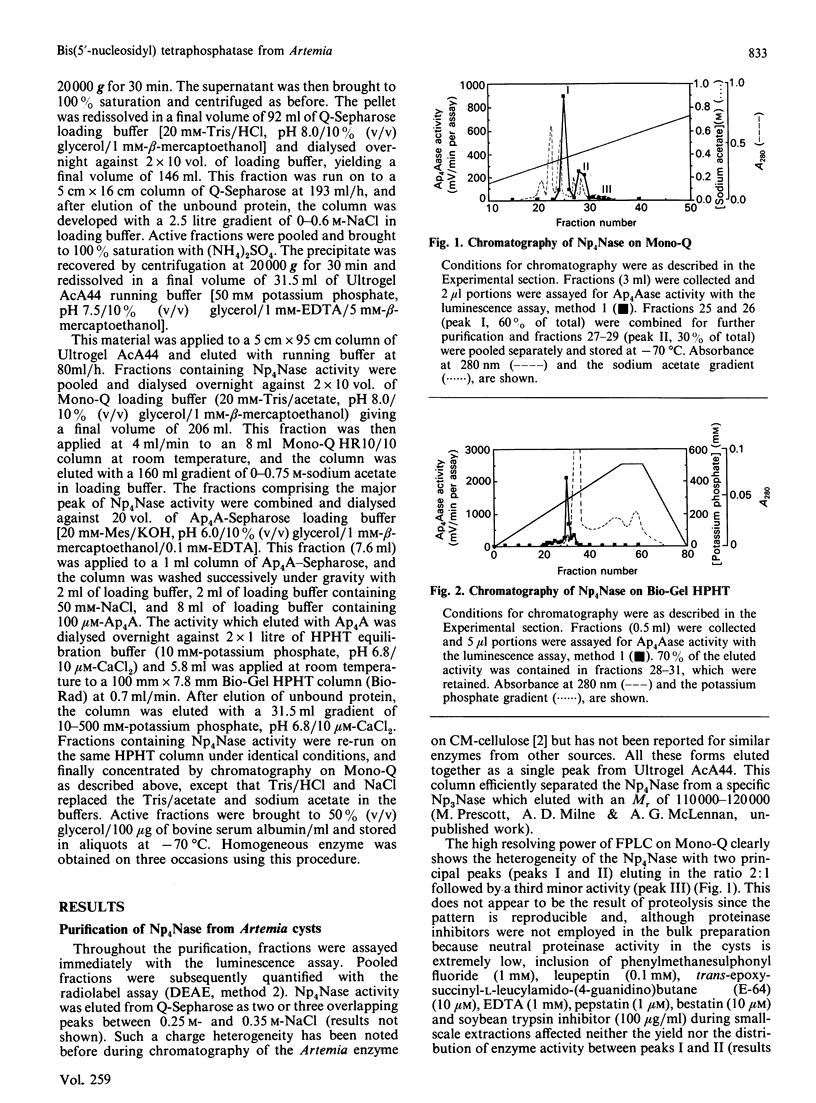
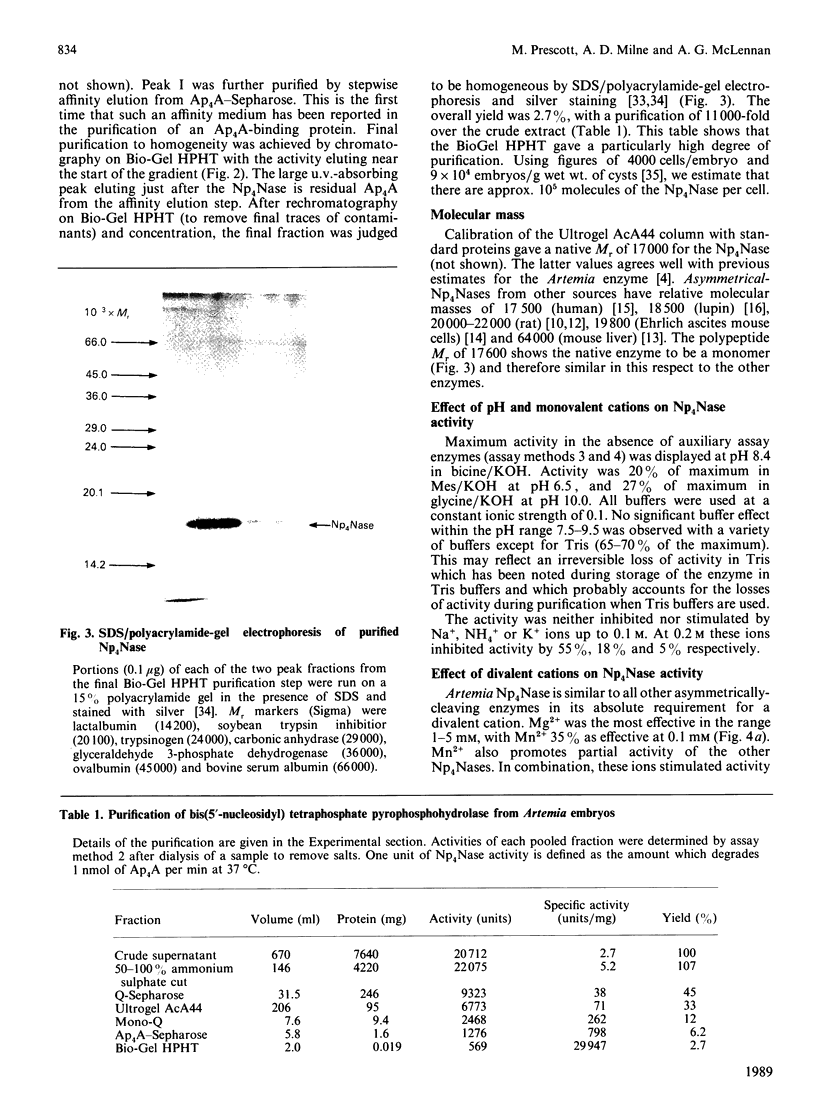
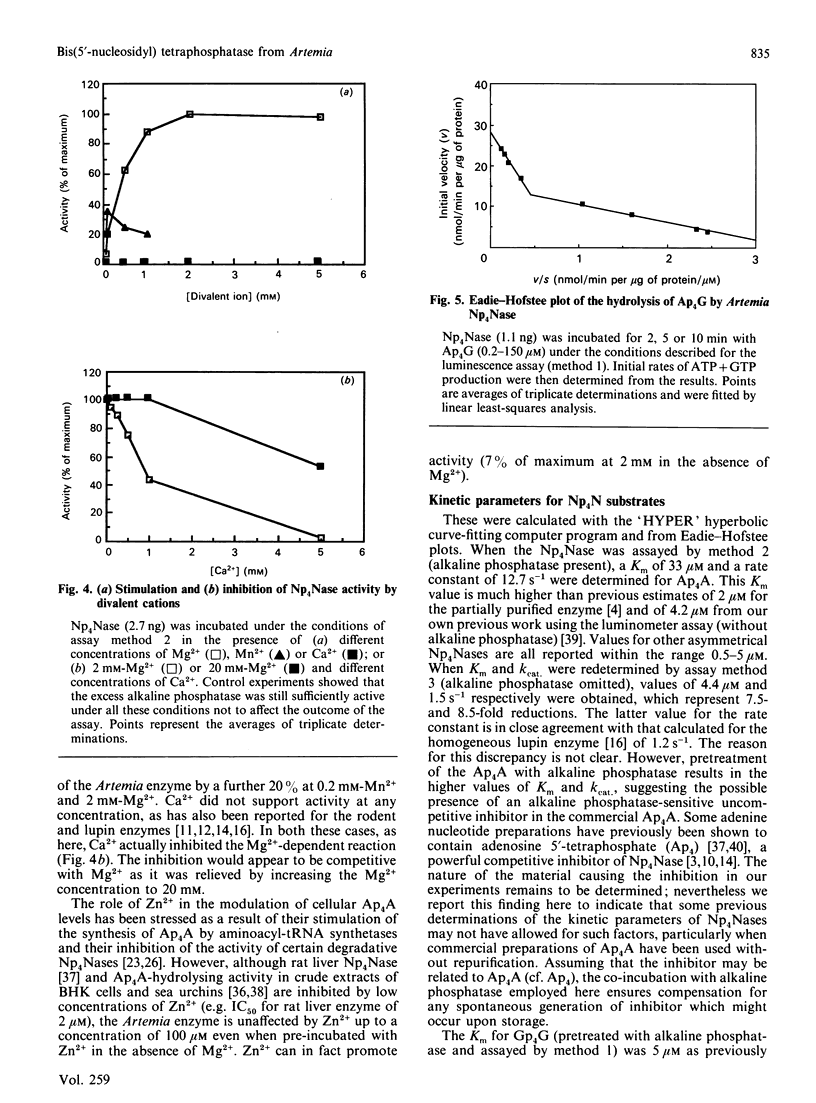
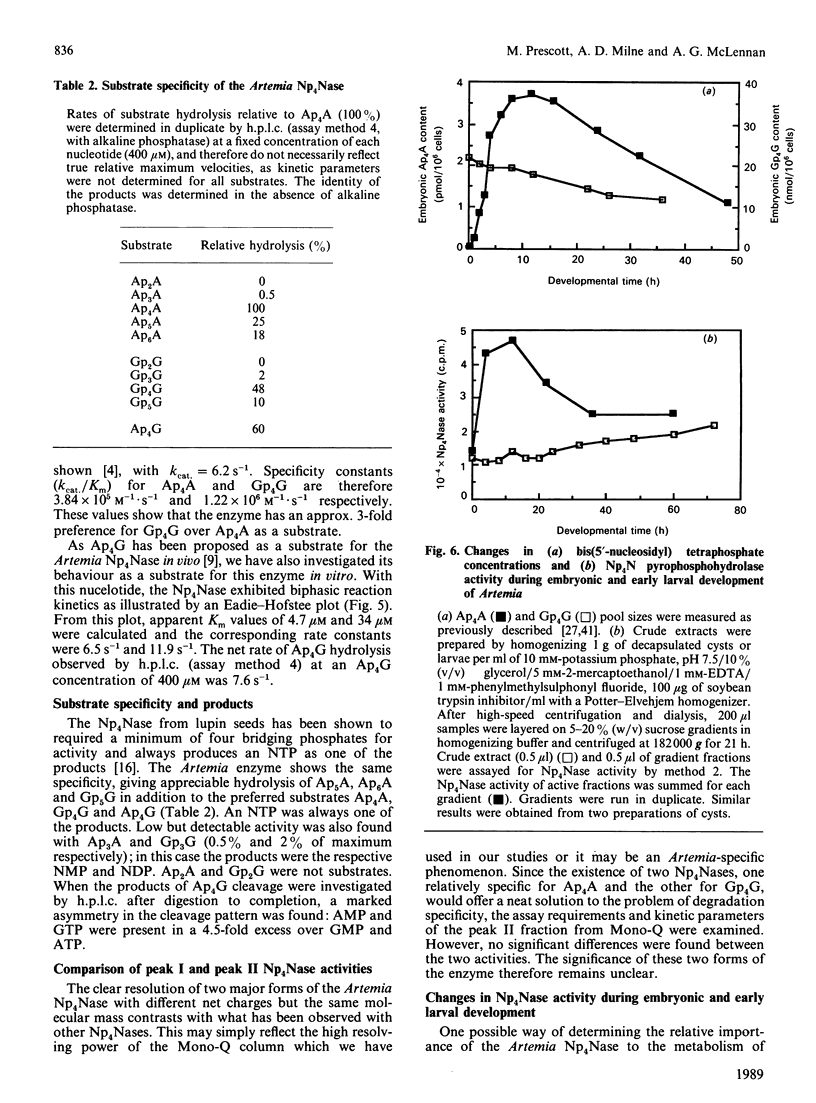
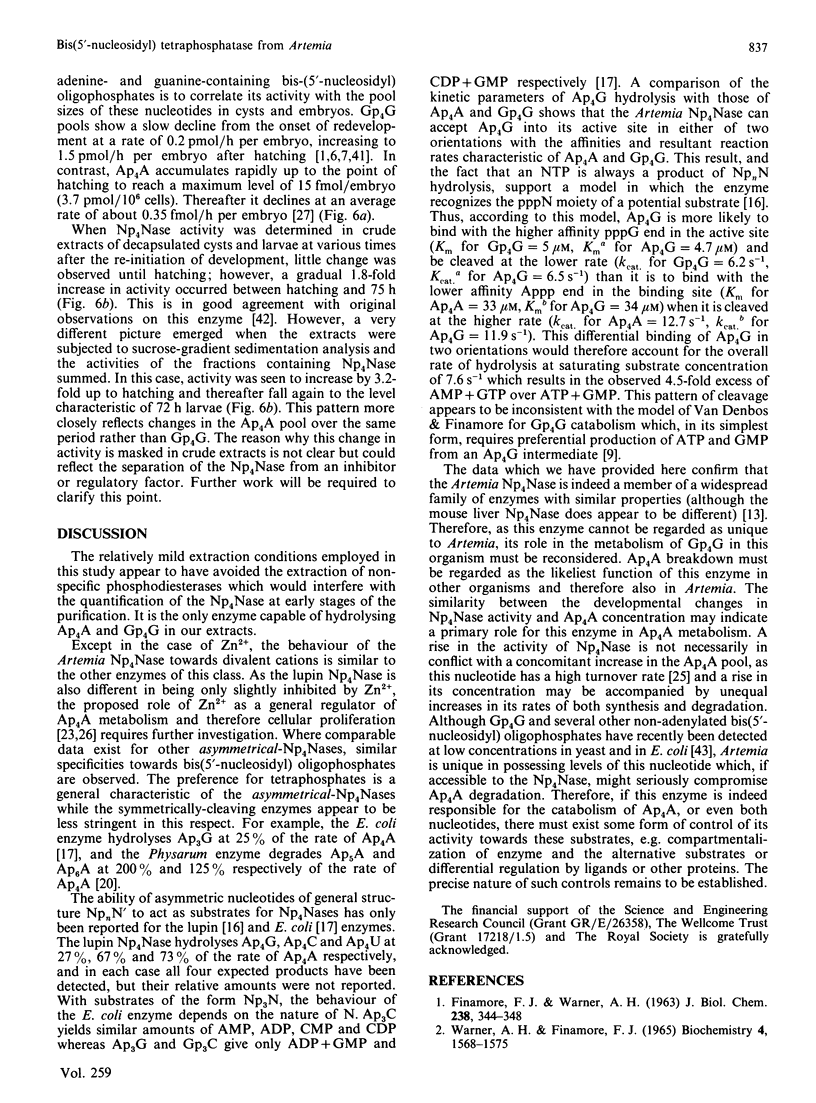
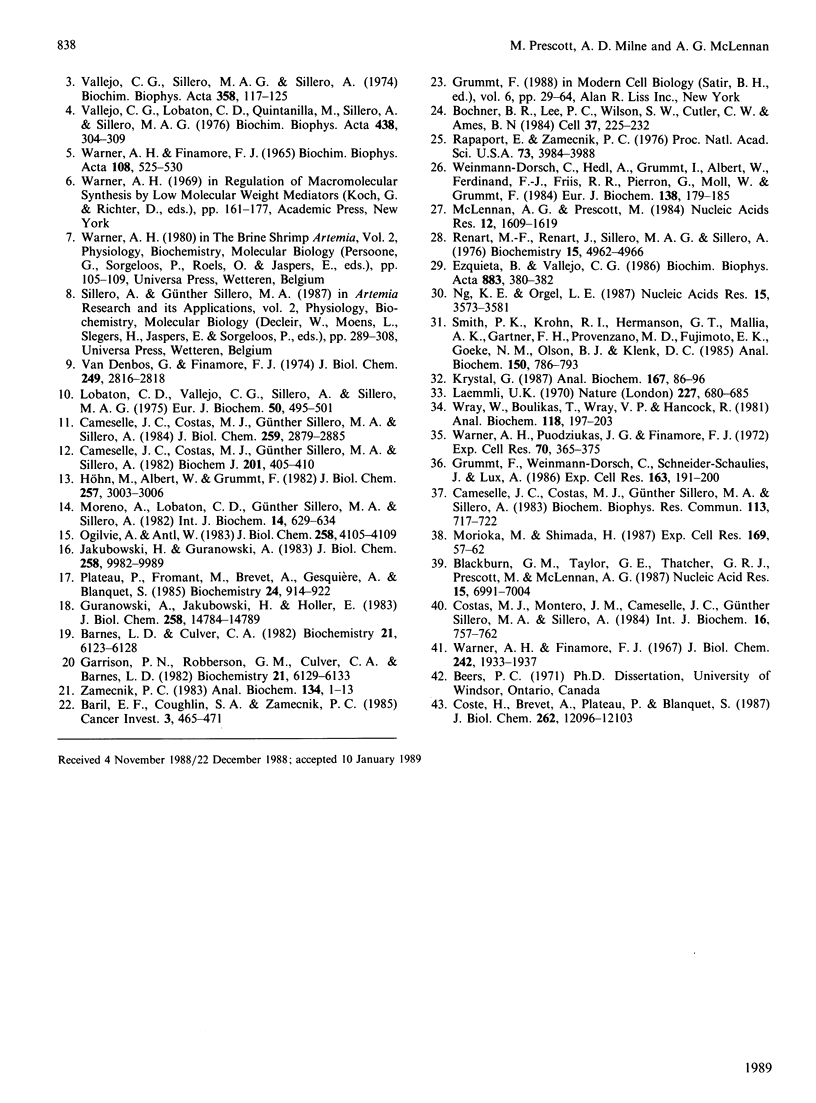
Images in this article
Selected References
These references are in PubMed. This may not be the complete list of references from this article.
- Baril E. F., Coughlin S. A., Zamecnik P. C. 5',5'''-P1, P4 diadenosine tetraphosphate (Ap4A): a putative initiator of DNA replication. Cancer Invest. 1985;3(5):465–471. doi: 10.3109/07357908509039808. [DOI] [PubMed] [Google Scholar]
- Barnes L. D., Culver C. A. Isolation and characterization of diadenosine 5',5"'-P1,P4-tetraphosphate pyrophosphohydrolase from Physarum polycephalum. Biochemistry. 1982 Nov 23;21(24):6123–6128. doi: 10.1021/bi00267a015. [DOI] [PubMed] [Google Scholar]
- Blackburn G. M., Taylor G. E., Thatcher G. R., Prescott M., McLennan A. G. Synthesis and resistance to enzymic hydrolysis of stereochemically-defined phosphonate and thiophosphate analogues of P1,P4-bis(5'-adenosyl) tetraphosphate. Nucleic Acids Res. 1987 Sep 11;15(17):6991–7004. doi: 10.1093/nar/15.17.6991. [DOI] [PMC free article] [PubMed] [Google Scholar]
- Bochner B. R., Lee P. C., Wilson S. W., Cutler C. W., Ames B. N. AppppA and related adenylylated nucleotides are synthesized as a consequence of oxidation stress. Cell. 1984 May;37(1):225–232. doi: 10.1016/0092-8674(84)90318-0. [DOI] [PubMed] [Google Scholar]
- Cameselle J. C., Costas M. J., Günther Sillero M. A., Sillero A. Two low Km hydrolytic activities on dinucleoside 5',5"'-P1,P4-tetraphosphates in rat liver. Characterization as the specific dinucleoside tetraphosphatase and a phosphodiesterase I-like enzyme. J Biol Chem. 1984 Mar 10;259(5):2879–2885. [PubMed] [Google Scholar]
- Cameselle J. C., Costas M. J., Sillero M. A., Sillero A. Bis-(5'-guanosyl) tetraphosphatase in rat tissues. Biochem J. 1982 Feb 1;201(2):405–410. doi: 10.1042/bj2010405. [DOI] [PMC free article] [PubMed] [Google Scholar]
- Cameselle J. C., Costas M. J., Sillero M. A., Sillero A. Dinucleosidetetraphosphatase inhibition by Zn(II). Biochem Biophys Res Commun. 1983 Jun 15;113(2):717–722. doi: 10.1016/0006-291x(83)91785-0. [DOI] [PubMed] [Google Scholar]
- Costas M. J., Montero J. M., Cameselle J. C., Sillero M. A., Sillero A. Dinucleosidetriphosphatase from rat brain. Int J Biochem. 1984;16(7):757–762. doi: 10.1016/0020-711x(84)90186-1. [DOI] [PubMed] [Google Scholar]
- Coste H., Brevet A., Plateau P., Blanquet S. Non-adenylylated bis(5'-nucleosidyl) tetraphosphates occur in Saccharomyces cerevisiae and in Escherichia coli and accumulate upon temperature shift or exposure to cadmium. J Biol Chem. 1987 Sep 5;262(25):12096–12103. [PubMed] [Google Scholar]
- FINAMORE F. J., WARNER A. H. The occurrence of P1, P4-diguanosine 5'-tetraphosphate in brine shrimp eggs. J Biol Chem. 1963 Jan;238:344–348. [PubMed] [Google Scholar]
- Garrison P. N., Roberson G. M., Culver C. A., Barnes L. D. Diadenosine 5',5"'-P1,P4-tetraphosphate pyrophosphohydrolase from Physarum polycephalum. Substrate specificity. Biochemistry. 1982 Nov 23;21(24):6129–6133. doi: 10.1021/bi00267a016. [DOI] [PubMed] [Google Scholar]
- Grummt F., Weinmann-Dorsch C., Schneider-Schaulies J., Lux A. Zinc as a second messenger of mitogenic induction. Effects on diadenosine tetraphosphate (Ap4A) and DNA synthesis. Exp Cell Res. 1986 Mar;163(1):191–200. doi: 10.1016/0014-4827(86)90572-0. [DOI] [PubMed] [Google Scholar]
- Guranowski A., Jakubowski H., Holler E. Catabolism of diadenosine 5',5"'-P1,P4-tetraphosphate in procaryotes. Purification and properties of diadenosine 5',5"'-P1,P4-tetraphosphate (symmetrical) pyrophosphohydrolase from Escherichia coli K12. J Biol Chem. 1983 Dec 25;258(24):14784–14789. [PubMed] [Google Scholar]
- Höhn M., Albert W., Grummt F. Diadenosine tetraphosphate hydrolase from mouse liver. Purification to homogeneity and partial characterization. J Biol Chem. 1982 Mar 25;257(6):3003–3006. [PubMed] [Google Scholar]
- Jakubowski H., Guranowski A. Enzymes hydrolyzing ApppA and/or AppppA in higher plants. Purification and some properties of diadenosine triphosphatase, diadenosine tetraphosphatase, and phosphodiesterase from yellow lupin (Lupinus luteus) seeds. J Biol Chem. 1983 Aug 25;258(16):9982–9989. [PubMed] [Google Scholar]
- Krystal G. A silver-binding assay for measuring nanogram amounts of protein in solution. Anal Biochem. 1987 Nov 15;167(1):86–96. doi: 10.1016/0003-2697(87)90136-9. [DOI] [PubMed] [Google Scholar]
- Laemmli U. K. Cleavage of structural proteins during the assembly of the head of bacteriophage T4. Nature. 1970 Aug 15;227(5259):680–685. doi: 10.1038/227680a0. [DOI] [PubMed] [Google Scholar]
- Lobatón C. D., Vallejo C. G., Sillero A., Sillero M. A. Diguanosinetetraphosphatase from rat liver: Acitivity on diadenosine tetraphosphate and inhibition by adenosine tetraphosphate. Eur J Biochem. 1975 Jan 15;50(3):495–501. doi: 10.1111/j.1432-1033.1975.tb09888.x. [DOI] [PubMed] [Google Scholar]
- McLennan A. G., Prescott M. Diadenosine 5',5'"-P1,P4-tetraphosphate in developing embryos of Artemia. Nucleic Acids Res. 1984 Feb 10;12(3):1609–1619. doi: 10.1093/nar/12.3.1609. [DOI] [PMC free article] [PubMed] [Google Scholar]
- Moreno A., Lobatón C. D., Sillero M. A., Sillero A. Dinucleosidetetraphosphatase from Ehrlich ascites tumour cells: inhibition by adenosine, guanosine and uridine 5'-tetraphosphates. Int J Biochem. 1982;14(7):629–634. doi: 10.1016/0020-711x(82)90047-7. [DOI] [PubMed] [Google Scholar]
- Morioka M., Shimada H. AP4A-hydrolysing activity in sea urchin embryos. Exp Cell Res. 1987 Mar;169(1):57–62. doi: 10.1016/0014-4827(87)90224-2. [DOI] [PubMed] [Google Scholar]
- Ng K. E., Orgel L. E. The action of a water-soluble carbodiimide on adenosine-5'-polyphosphates. Nucleic Acids Res. 1987 Apr 24;15(8):3573–3580. doi: 10.1093/nar/15.8.3573. [DOI] [PMC free article] [PubMed] [Google Scholar]
- Ogilvie A., Antl W. Diadenosine tetraphosphatase from human leukemia cells. Purification to homogeneity and partial characterization. J Biol Chem. 1983 Apr 10;258(7):4105–4109. [PubMed] [Google Scholar]
- Plateau P., Fromant M., Brevet A., Gesquière A., Blanquet S. Catabolism of bis(5'-nucleosidyl) oligophosphates in Escherichia coli: metal requirements and substrate specificity of homogeneous diadenosine-5',5'''-P1,P4-tetraphosphate pyrophosphohydrolase. Biochemistry. 1985 Feb 12;24(4):914–922. doi: 10.1021/bi00325a016. [DOI] [PubMed] [Google Scholar]
- Rapaport E., Zamecnik P. C. Presence of diadenosine 5',5''' -P1, P4-tetraphosphate (Ap4A) in mamalian cells in levels varying widely with proliferative activity of the tissue: a possible positive "pleiotypic activator". Proc Natl Acad Sci U S A. 1976 Nov;73(11):3984–3988. doi: 10.1073/pnas.73.11.3984. [DOI] [PMC free article] [PubMed] [Google Scholar]
- Renart M. F., Renart J., Sillero M. A., Sillero A. Guanosine monophosphate reductase from Artemia salina: Inhibition by xanthosine monophosphate and activation by diguanosine tetraphosphate. Biochemistry. 1976 Nov 16;15(23):4962–4966. doi: 10.1021/bi00668a003. [DOI] [PubMed] [Google Scholar]
- Vallejo C. G., Lobaton C. D., Quintanilla M., Sillero A., Sillero M. A. Dinucleosidasetetraphosphatase in rat liver and Artemia salina. Biochim Biophys Acta. 1976 Jun 7;438(1):304–309. doi: 10.1016/0005-2744(76)90246-1. [DOI] [PubMed] [Google Scholar]
- Vallejo C. G., Sillero M. A., Sillero A. Diguanosinetetraphosphate guanylohydrolase in Artemia salina. Biochim Biophys Acta. 1974 Jul 17;358(1):117–125. doi: 10.1016/0005-2744(74)90264-2. [DOI] [PubMed] [Google Scholar]
- Van Denbos G., Finamore F. J. An unusual pathway for the synthesis of adenosine triphosphate by the purine-requiring organism Artemia salina. J Biol Chem. 1974 May 10;249(9):2816–2818. [PubMed] [Google Scholar]
- Warner A. H., Finamore F. J. Isolation, purification, and characterization of P1,P3-diguanosine 5'-triphosphate from brine shrimp eggs. Biochim Biophys Acta. 1965 Dec 9;108(4):525–530. doi: 10.1016/0005-2787(65)90049-3. [DOI] [PubMed] [Google Scholar]
- Warner A. H., Finamore F. J. Isolation, purification, and characterization of P1,P4-diguanosine 5'-tetraphosphate asymmetrical-pyrophosphohydrolase from brine shrimp eggs. Biochemistry. 1965 Aug;4(8):1568–1575. doi: 10.1021/bi00884a016. [DOI] [PubMed] [Google Scholar]
- Warner A. H., Finamore F. J. Nucleotide metabolism during brine shrimp embryogenesis. J Biol Chem. 1967 Apr 25;242(8):1933–1937. [PubMed] [Google Scholar]
- Warner A. H., Puodziukas J. G., Finamore F. J. Yolk platelets in brine shrimp embryos. Site of biosynthesis and storage of the diguanosine nucleotides. Exp Cell Res. 1972 Feb;70(2):365–375. doi: 10.1016/0014-4827(72)90148-6. [DOI] [PubMed] [Google Scholar]
- Weinmann-Dorsch C., Hedl A., Grummt I., Albert W., Ferdinand F. J., Friis R. R., Pierron G., Moll W., Grummt F. Drastic rise of intracellular adenosine(5')tetraphospho(5')adenosine correlates with onset of DNA synthesis in eukaryotic cells. Eur J Biochem. 1984 Jan 2;138(1):179–185. doi: 10.1111/j.1432-1033.1984.tb07897.x. [DOI] [PubMed] [Google Scholar]
- Wray W., Boulikas T., Wray V. P., Hancock R. Silver staining of proteins in polyacrylamide gels. Anal Biochem. 1981 Nov 15;118(1):197–203. doi: 10.1016/0003-2697(81)90179-2. [DOI] [PubMed] [Google Scholar]
- Zamecnik P. Diadenosine 5',5"'-P1,P4-tetraphosphate (Ap4A): its role in cellular metabolism. Anal Biochem. 1983 Oct 1;134(1):1–10. doi: 10.1016/0003-2697(83)90255-5. [DOI] [PubMed] [Google Scholar]



